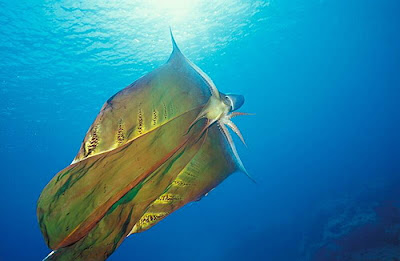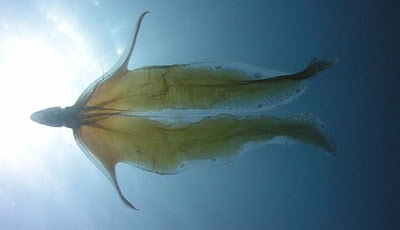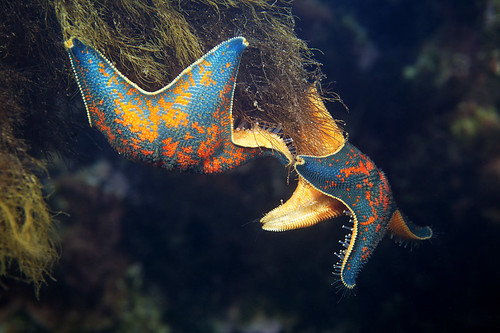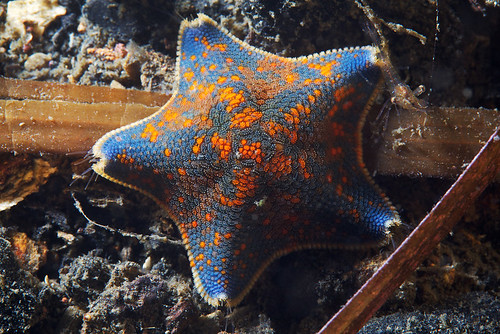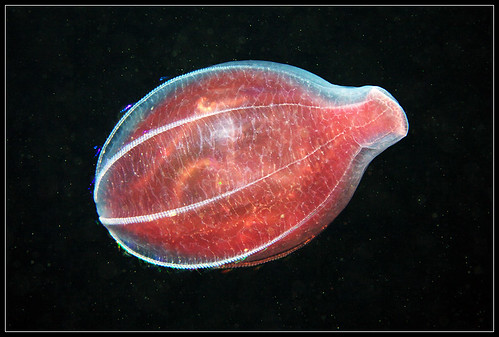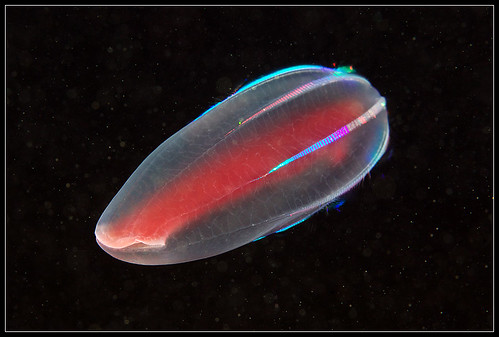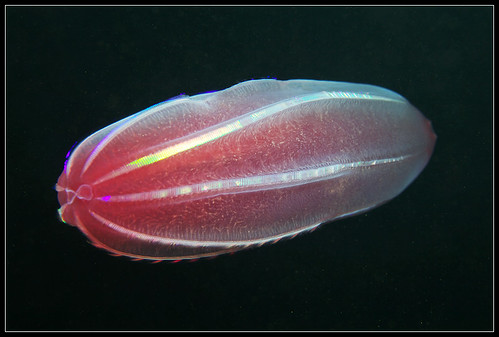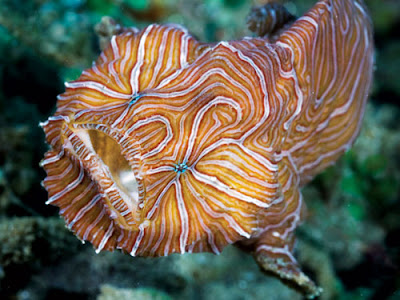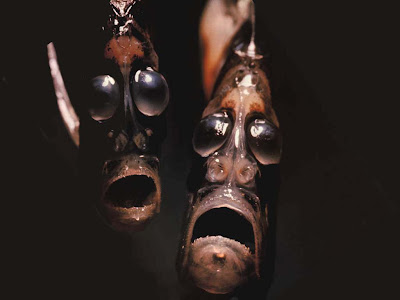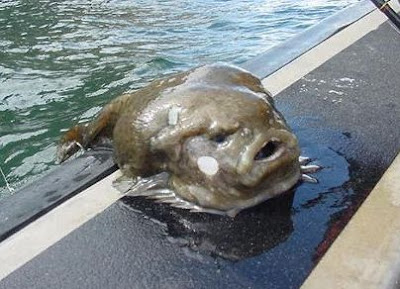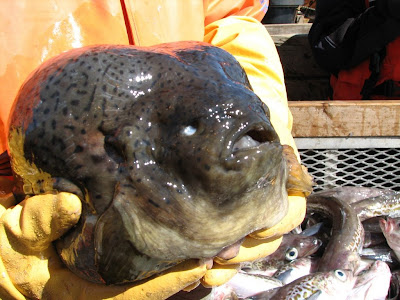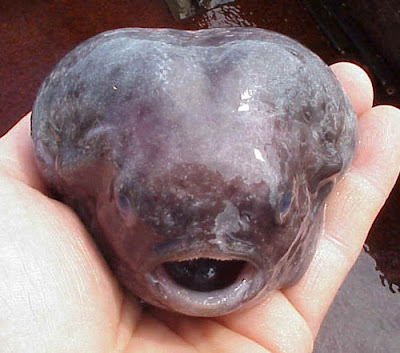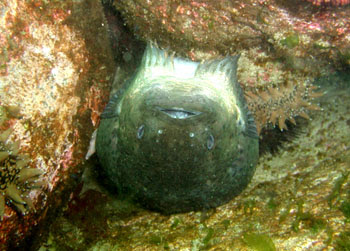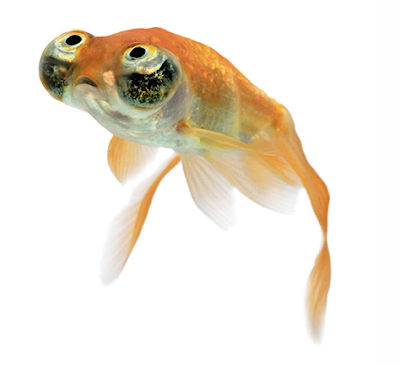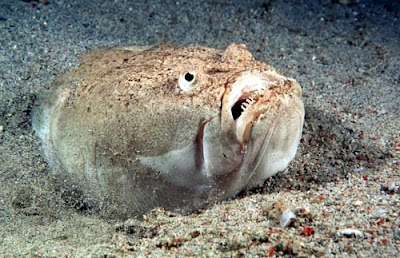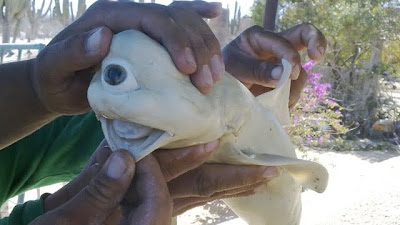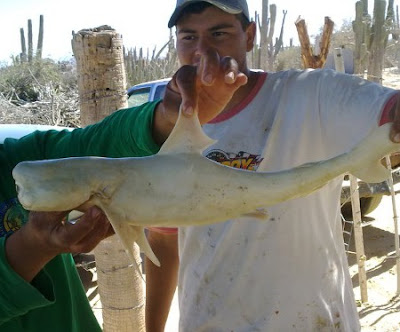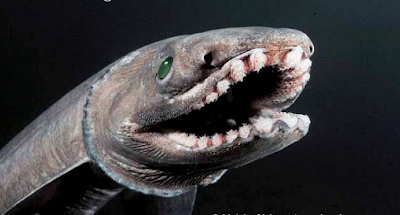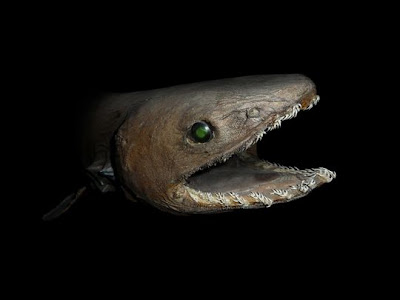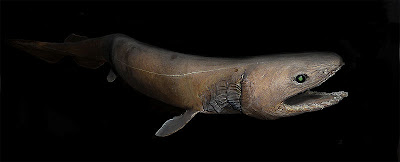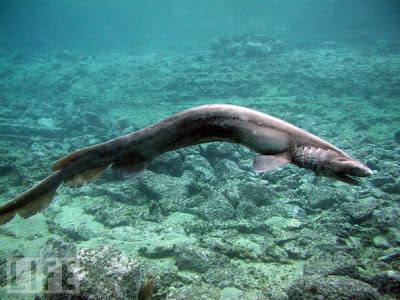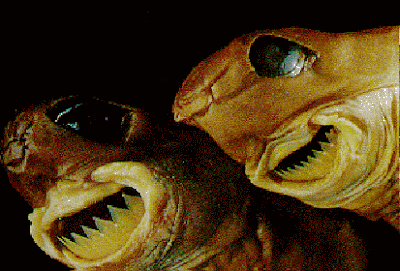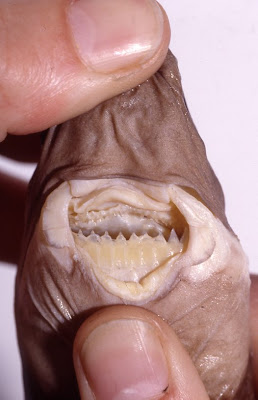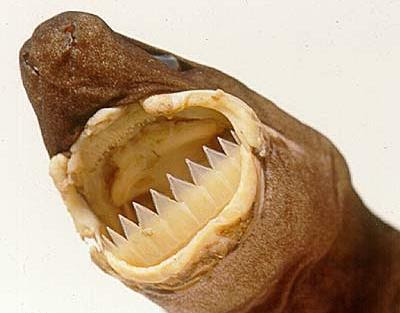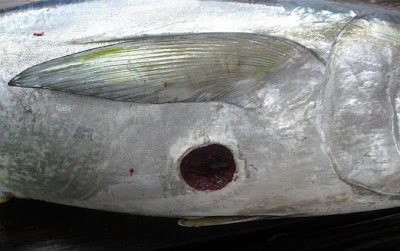sea creatures
Kategori: övernaturligt
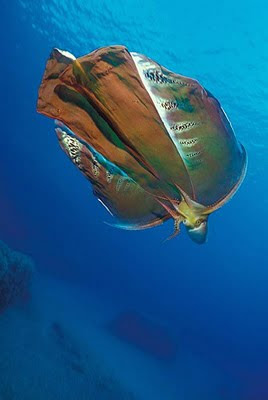 image credit: atom.com
image credit: atom.comMale
Habitat: pelagic zones of subtropical and tropical oceans
Status: Not evaluated
What's funny about these creatures is their pronounced sexual dimorphism - females can grow to over 2 meters in length whereas the teeny males only reach around a few centimeters!
Blanket octopuses also have a few tricks up their sleeves. The creatures are immune to the venom of Portuguese Man o' War and will actually rip off the jellyfish's tentacles and carry them around for their own defense.
The most impressive defense mechanism though stems from the Blanket Octopuses lack of ink. Instead of using ink to scare off predators, the female (when threatened) will unfurl her large net-like membranes which billow gracefully in the water behind her. This "blanket" greatly increases her apparent size and I'm sure scares the bajeezes out of any potential predator.
Check out this great video of the Blanket Octopus unfurling her "blanket" and swimming about:
Catch More Creatures Here: http://www.thefeaturedcreature.com/2010/12/curl-up-with-blanket-octopus.html#ixzz1raAZ3B3f
This looks like something straight out of a Van Gogh painting. Imagine coming across this in a tidepool!
Catch More Creatures Here: http://www.thefeaturedcreature.com/search/label/colorful#ixzz1raB1KGlM
This deep sea Comb Jelly (Beroe abyssicola) looks like something from another world. I think that the deep sea is one of my favorite biomes on Earth. Every time I see a creature from down below it shocks me - these things are just sooo bizarre! Not to mention it's incredible that ANYTHING can survive the extreme cold and pressure under the sea like that.
Photographer Alexander Semenov captured some incredible photos of this rarely seen jelly. I love how you can see inside the creature as well as it's gorgeous rainbow cilia (what it uses to move around with).
Catch More Creatures Here: http://www.thefeaturedcreature.com/search/label/weird#ixzz1raByEOMT
Black Swallowers get their name from swallowing their prey, which consist of bony fish, whole. Now here's where things get really weird - its food can be over twice the swallower's size and TEN TIMES its mass!
Most specimens that have been recovered were found after undigested fish inside the [already dead] swallower produced gases that sent the sucker ballooning up to the surface of the ocean where it could be collected.
Thanks Jennifer Paul, for recommending this creature!
The pattern of stripes on the Psychedelic Frogfish acts much like zebra stripes or the spots on humpback whale tails in that it is unique to that particular frogfish. Scientists can identify the frogfish, therefore, by its unique fingerprint-like pattern.
One of my favorite things about this fish is its form of locomotion. Normally the frogfish uses its hand-like fins to walk along the bottom of the ocean. However, in some cases it will use its fins to push off from the ocean floor while at the same time shooting water through its gills to propel itself forward via jet propulsion. The reason why this is so cool is that when doing so, the fish takes on a ball shape, making it look like a trippy beach ball floating through the water. Gnarly!
Catch More Creatures Here: http://www.thefeaturedcreature.com/search/label/weird#ixzz1raCfGf7m
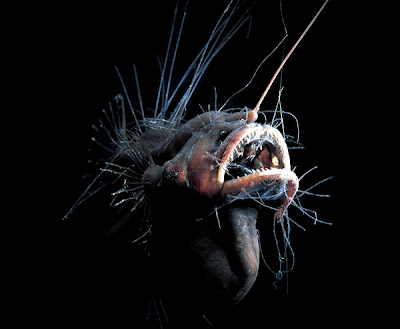 image credit: David Shale, thedeepbook.org
image credit: David Shale, thedeepbook.orgHabitat: deep, lightless waters of the Atlantic, Pacific, and Indian Oceans
This type of anglerfish is distinguished from others by its lack of an expanded escal bulb - the bioluminescent lure that anglerfish use to entice their prey towards their jagged-toothed mouths - and by the very long dorsal & anal fin rays.
They also like little guys, as the male only gets to be a 1/2 inch long, while the female is 8 inches or more. I'll never understand that attraction.
Well, off to some gruesome nightmares!
Catch More Creatures Here: http://www.thefeaturedcreature.com/2010/08/fanfin-seadevils-will-haunt-me-in-my.html#ixzz1raCzKmrD
 image credit: science7miller.glogster.com
image credit: science7miller.glogster.comHabitat: tropical and subtropical deep ocean waters of the Atlantic, Pacific, and Indian Oceans
Status: Not Evaluated
To me these fish don't really look that scary they look more sad. Maybe they're crying out to us for companionship, since I would assume living hundreds of meters below the surface of the ocean must be grounds for a very lonely existence. Not sure I would go out of my way to help befriend them though...
Catch More Creatures Here: http://www.thefeaturedcreature.com/2010/10/friends-with-hatchetfish.html#ixzz1raDm6lbW
Status: No Conservation Concerns
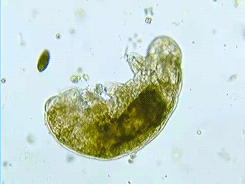
One of the most interesting aspects of the moss piglet, or water bear, is the ability it has to survive, and even flourish, in environments that we typically think of as uninhabitable. Some can survive temperatures of close to absolute zero (which is −459 °F, mind you); others can withstand temps as high as 304 °F. Not only that, they can take 1,000 times more radiation than other animals, and can go a DECADE without water! Insane!!!
Oh, and last but not least, they can survive in space. So watch out, because water bears might take over the universe someday [soon].
Catch More Creatures Here: http://www.thefeaturedcreature.com/search/label/sea#ixzz1raEYOmF4
Growing to around 30cm in length, I'd have to say this is one of the most bizarre and beautiful species of fish I've seen in a while... and that's saying something!
Catch More Creatures Here: http://www.thefeaturedcreature.com/search/label/beautiful#ixzz1raGM67Ea
Below is a collection of several fish species and what they looked like before and AFTER their growth spurts. Get ready for some craziness...
(Danio rerio)
(Taenianotus triacanthus)
Catch More Creatures Here: http://www.thefeaturedcreature.com/search/label/fish#ixzz1raI5Tfbk
 image credit: storymillernoaa2010tas.blogspot.com
image credit: storymillernoaa2010tas.blogspot.comHabitat: found in the cold waters of the Arctic, North Atlantic, and North Pacific oceans
Status: Not evaluated
These guys are very appropriately named, with their drab coloration and not exactly pageant-ready appearance with those bulbous lumps. The sucker part of its name is derived from the modified pelvic fins which have evolved into suction-cup like discs that the Smooth Lumpsuckers use to attach themselves to rocks (see the 2nd to last picture).
I still think these guys deserve a hug :)
Catch More Creatures Here: http://www.thefeaturedcreature.com/search/label/fish#ixzz1raIJbyrg
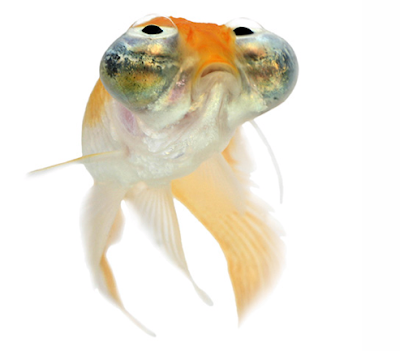 image credit: AndreJenny.com
image credit: AndreJenny.com image credit: AndreJenny.com
image credit: AndreJenny.com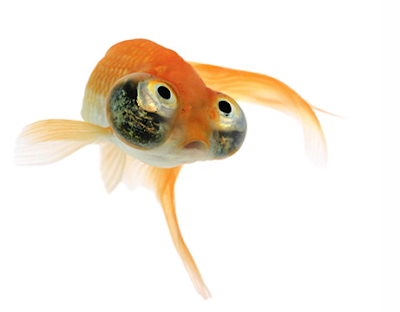 image credit: AndreJenny.com
image credit: AndreJenny.com image credit: AndreJenny.com
image credit: AndreJenny.comHabitat: Domestic, Originated in China
Status: ---
Anyways, did you ever own a fancy-shmancy Celestial Eye Goldfish? These guys are defined by their eyes which are turned upwards, pupils gazing skyward.
The first documentation that Celestials existed appears on a Chinese scroll of 1772, where a goldfish lacking a dorsal fin and possessing protuberant upturned eyes is depicted.
Cuties. Still bet mine wouldn't survive more than a few days though :(
Catch More Creatures Here: http://www.thefeaturedcreature.com/search/label/fish#ixzz1raIaa1Gv
 image credit: Andrew Newton UW
image credit: Andrew Newton UW image credit: Keri Wilk/Barcroft Media, guardian.co.uk
image credit: Keri Wilk/Barcroft Media, guardian.co.ukHabitat: worldwide in shallow waters
Status: Not listed
With over 50 species inhabiting shallow waters around the globe, you could definitely encounter this creature if you're ever diving in the ocean, though you might not even notice it. Stargazers bury themselves in the sand so that only their eyes and mouth are exposed (their eyes always look to the sky, hence their name).
When a fish swims overhead THEY better have revered that ugly fish or it won't be looking good for them. The Stargazers leap upward and snatch up the prey before you can say "WHAT THE - ". Some even have lures on their heads to draw the fish closer.
Oh and if that isn't enough, every Stargazer is venomous with two poison spines hidden above the pectoral fins and near the gills. Electric shocks are also in this fish's arsenal.
Better get praying.
Catch More Creatures Here: http://www.thefeaturedcreature.com/search/label/fish#ixzz1raInWf8s
Catch More Creatures Here: http://www.thefeaturedcreature.com/search/label/bizarre#ixzz1raJ8EUU4
Found this little cutie over at Neatorama. Life is so weird sometimes.
"According to the Pisces Fleet Sportsfishing blog, this one-eyed bull shark fetus was removed from a mother caught in Mexico's Sea of Cortez. Apparently shark researcher Felipe Galvan Magaña is now examining this monocular specimen."
Catch More Creatures Here: http://www.thefeaturedcreature.com/search/label/bizarre#ixzz1raJJQIZP
 image credit: nothingtoxic.blogspot.com
image credit: nothingtoxic.blogspot.comHabitat: outer continental shelf and upper to middle continental slope of the Atlantic and Pacific Oceans
Status: Near Threatened

This rarely observed and strange looking creature is a Frilled Shark. The species made headlines in 2007 when a Japanese fisherman spotted the shark near the ocean's surface and transported it to a marine park for observation. Normally the shark is found thousands of feet below the water's surface so it was speculated that this one came up because it was either injured or sick. Looks like that was true, because the Frilled Shark unfortunately died hours later.
The bizarre creature hasn't changed much in its evolutionary history, which is why it is known as a "living fossil." With it's eel-like body and odd lizard-like head, some cryptozoologists have attributed sea serpent sightings of yor to the Frilled Shark.
The shark is named for its six pairs of collar-like gills with frilly edges. Like most aspects of the Frilled Shark, how it eats is a mystery. However, some believe that it captures its prey by bending its body and lunging forward like a snake.
Here's the footage taken from the Japanese marine park when the living specimen of the Frilled Shark was captured:
Catch More Creatures Here: http://www.thefeaturedcreature.com/search/label/deep%20sea#ixzz1raKREdkL
 image credit: forum.przyroda.org
image credit: forum.przyroda.org image credit: jeanbont.pbworks.com
image credit: jeanbont.pbworks.comHabitat: warm ocean waters worldwide
Status: Least Concern
 Ah, the holidays. Such a wonderful time of the year don't you think? You get to see family, get great presents, and of course indulge in some sugary foods. Making holiday cookies is always a fun thing to do with kids; I remember I used to love picking out different cookiecutter shapes to make some cool designs out of the dough. I bring this up because this fish is the demented version of just that. Enter the Cookiecutter Shark.
Ah, the holidays. Such a wonderful time of the year don't you think? You get to see family, get great presents, and of course indulge in some sugary foods. Making holiday cookies is always a fun thing to do with kids; I remember I used to love picking out different cookiecutter shapes to make some cool designs out of the dough. I bring this up because this fish is the demented version of just that. Enter the Cookiecutter Shark.A relatively small creature, the Cookiecutter Shark reaches only 17-22 inches in length but its size doesn't take away from its nasty demeanor. Cookiecutter Sharks get their name from their gross habit of gouging out large chunks of flesh from other marine creatures, much like a cookiecutter (see the 3rd picture from the bottom). It uses its saw-like teeth and suction cup-like lips to latch on and then gnaw through the poor creatures body. There have also been several reported cases of human bodies found with "cookiecutter wounds."
Another odd feature of the shark is that it is bioluminescent. It glows bright green and has even been observed to do so for three hours after being taken out of the ocean. However, it does have a small dark patch that is unaffected by the luminescence which looks like a small dark fish. The Cookiecutter uses this patch to attract larger creatures which it then proceeds to munch on.
So who's in the mood to make some cookies now?!?
Catch More Creatures Here: http://www.thefeaturedcreature.com/search/label/deep%20sea#ixzz1raKfpkYW
 Habitat: Costa Rica's Coco Islands
Habitat: Costa Rica's Coco IslandsView this clip from "Nature" that features the rosy lipped batfish & frogfish:
Catch More Creatures Here: http://www.thefeaturedcreature.com/search/label/strange#ixzz1raMERTxZ
Over the past few years, rumors have circulated in Japan about the existence of gigantic humanoid life-forms inhabiting the icy waters of the Antarctic.
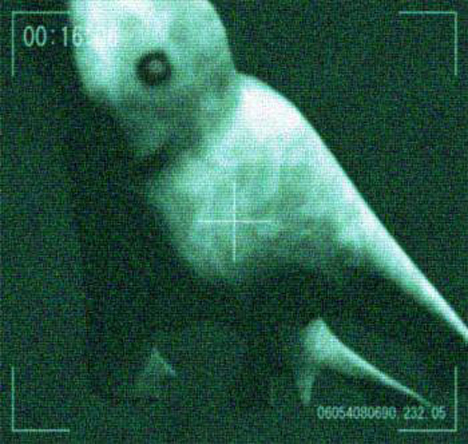
Hello, Ningen
Reportedly observed on multiple occasions by crew members of government-operated "whale research" ships, these so-called "Ningen" (lit. "humans") are said to be completely white in color with an estimated length of 20 to 30 meters. Eyewitnesses describe them as having a human-like shape, often with legs, arms, and even five-fingered hands. Sometimes they are described as having fins or a large mermaid-like tail instead of legs. The only visible facial features are the eyes and mouth.
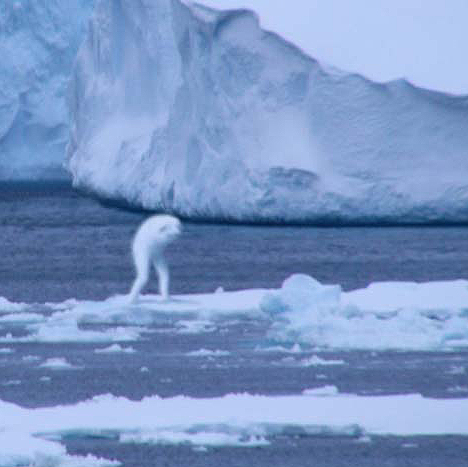
Artist's rendition of a Ningen standing upright
According to one account, crew members on deck observed what they initially thought was a foreign submarine in the distance. When they approached, however, it became clear from the irregular shape of the thing that it was not man-made -- it was alive. The creature quickly disappeared under water.
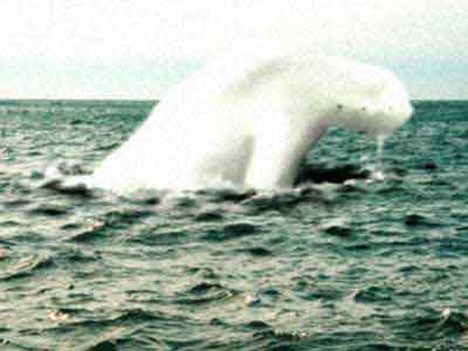
Ningen?
For the most part, the existence of the Ningen is considered an urban legend. Much of the information about this rumored creature can be traced back to a series of posts on the 2channel forums, written by a person describing the experience of a friend employed on a government "whale research" vessel. (Read the full Japanese text of the original story that first appeared on a 2channel forum.)
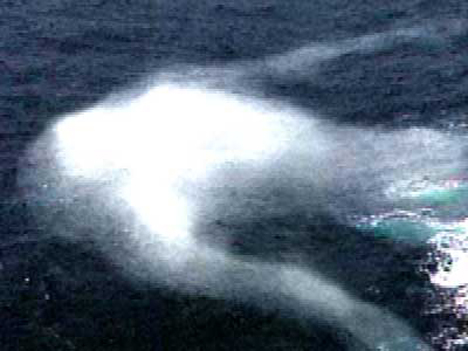
Ningen?
The popular thread attracted the attention of many readers from outside the 2channel community, and the November 2007 issue of MU magazine, a Japanese publication devoted to the study of paranormal phenomena, featured an article about the Antarctic humanoids.
The article speculated on the possibility of unidentified creatures inhabiting the southern seas, and it included a Google Maps screenshot showing what looks like a Ningen in the South Atlantic Ocean off the coast of Namibia.
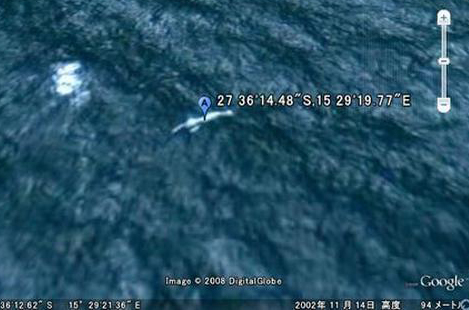
Link: Google Maps
To date, no solid evidence has been presented to confirm the existence of the Ningen. The government is believed to have kept detailed records of the sightings, but they have released no information to the public and have reportedly instructed eyewitnesses to remain silent
Ningen sightings seem to occur most frequently at night, making them all the more difficult to photograph. In still images, the sea cryptids mostly just look like icebergs, though it is said that their smooth, human-like skin can be seen when the photographs are enlarged.
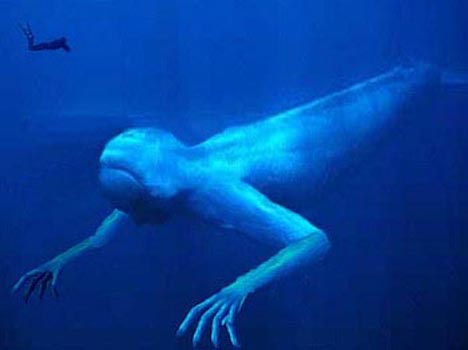
Artist's rendition of a mermaid-like Ningen
In any case, no convincing photographs have been made public, either because they do not exist or because, as some argue, the government does not want to invite undue scrutiny and tarnish the scientific reputation of the whale research program.
[Note: This is the first in a new series of weekly posts about urban legends and unexplained phenomena from Japan. Check back next week for another report.]


